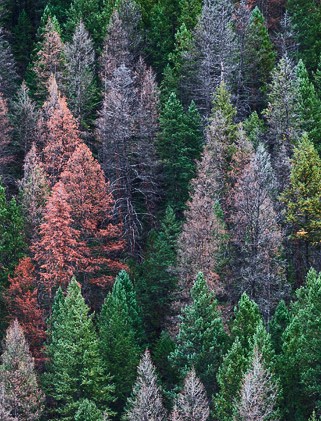Alliance Receives $10 Million To Research The Viability Of Using Beetles-Killed Trees As Biofuel
 November 23, 2013
November 23, 2013  Kyriaki (Sandy) Venetis
Kyriaki (Sandy) Venetis The Bioenergy Alliance Network of the Rockies (BANR)– a consortium of academic, industry, and government organizations led by Colorado State University – has been awarded $10 million by the U.S. Department of Agriculture to research the viability of using beetle-killed trees in the Rockies as a sustainable source for creating biofuels.
 Beetle damage in West Elk Mountains, Colorado. Photo by Jimmy Gekas.
Beetle damage in West Elk Mountains, Colorado. Photo by Jimmy Gekas.
Among the benefits of this plan would be the culling infested forests. Agriculture Secretary Tom Vilsack said earlier this month that, “Infestation of pine and spruce bark beetles have impacted over 42 million acres of U.S. forests since 1996, and a changing climate threatens to expand the threat from the bark beetle on our forest lands .”
This isn’t a new concern, and warming winters over the last several seasons have greatly exacerbated the growth of beetle populations and forest destruction.
In 2009, Matt Skoglund, director of the Natural Resource Defense Council’s (NRDC) Northern Rockies office , talked about “the tragic demise of whitebark pine trees in the Northern Rockies, primarily caused by the mountain pine beetles,” which he added were “thriving with a warmer climate.”
Skoglund continued that “the destructive paths of both the spruce beetle in the boreal forests of Canada and the mountain pine beetle in the Rockies, both of which, thanks to warming temperatures [were] wreaking havoc on coniferous forests and leaving millions of acres of dead trees in their wake.”
Skoglund also added that the worst case scenario was already unfolding, saying that warmer temperatures were “enabling beetles to survive at ever higher elevations” and that as a result, the whitebark pines without natural defenses, were “being slaughtered by beetles across the Northern Rockies.”
Colorado State University explained the role of extreme cold in controlling beetle populations, saying, “For winter mortality to be a significant factor, a severe freeze is necessary while the insect is in its most vulnerable stage, i.e., in the fall before the larvae have metabolized glycerols, or in late spring when the insect is molting into the pupal stage.
“For freezing temperatures to affect a large number of larvae during the middle of winter, temperatures of at least 30 degrees below zero (Fahrenheit) must be sustained for at least five days.”





